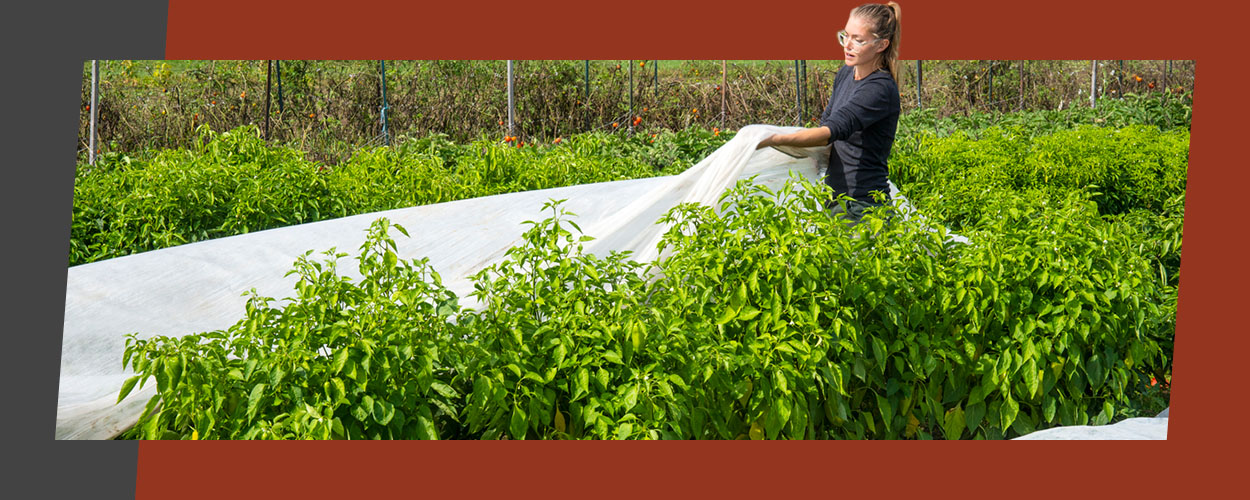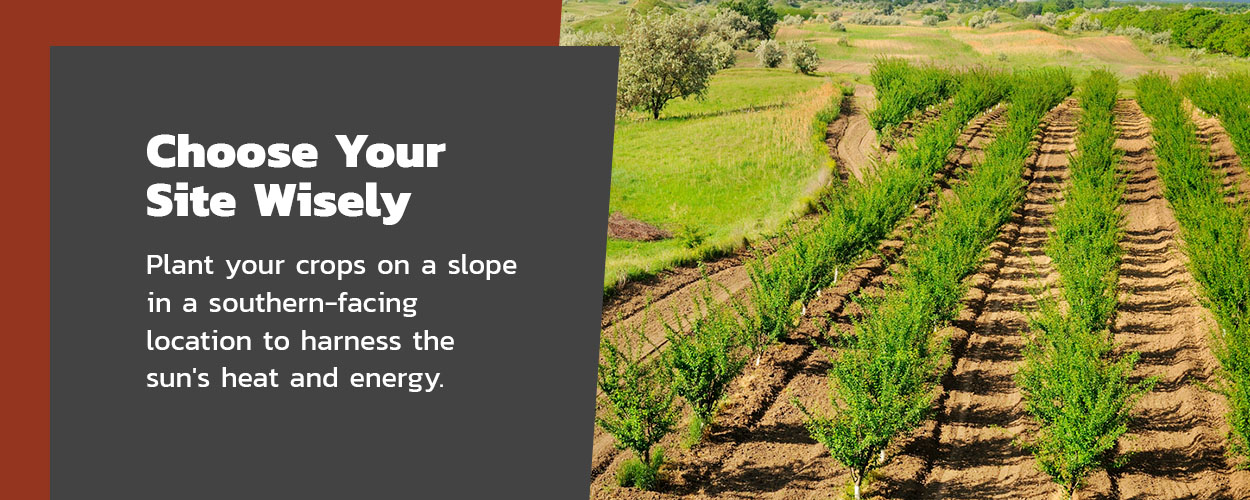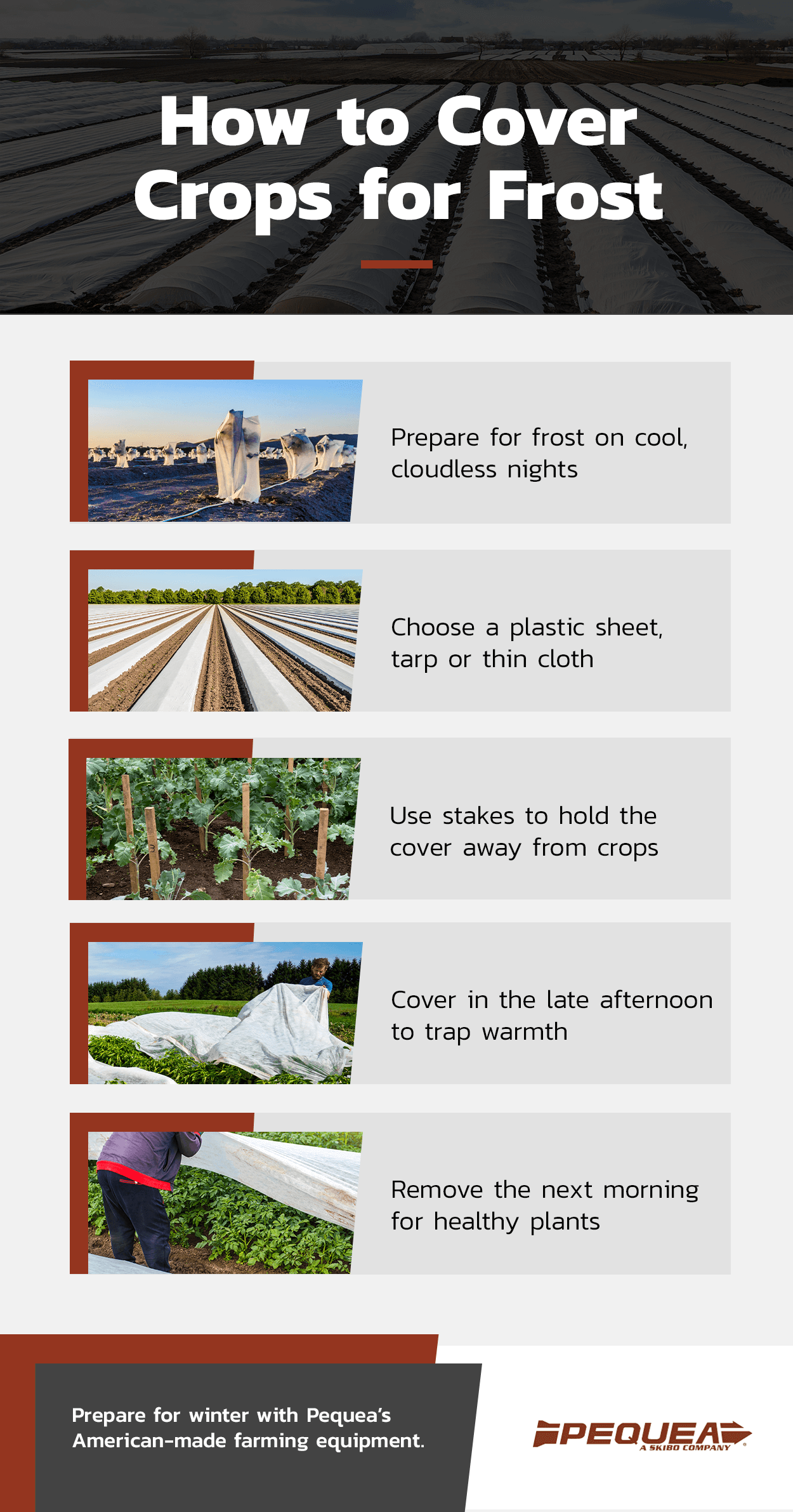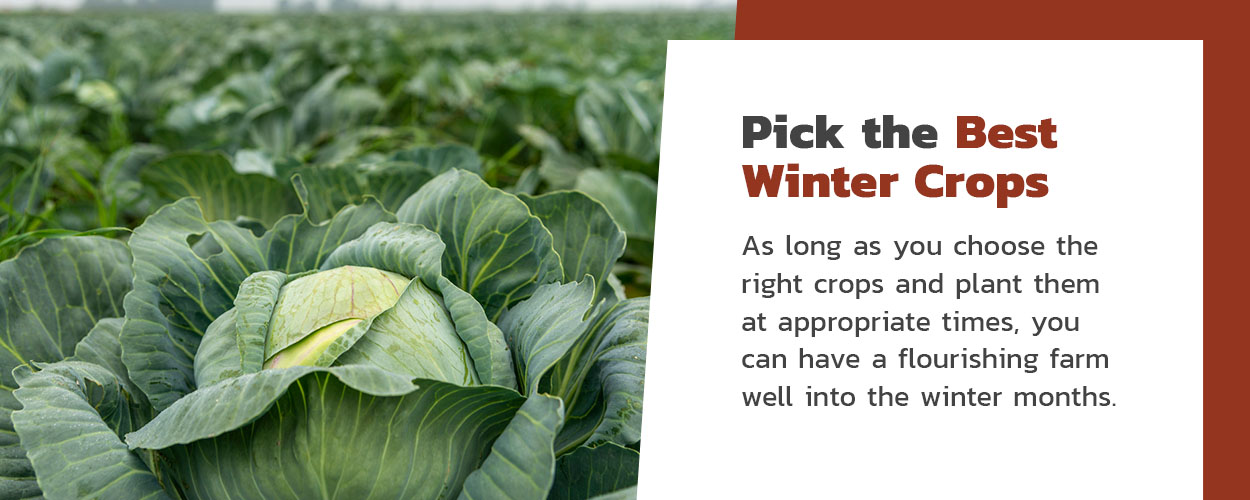Protecting Your Crops From Frost: 8 Tips and Tricks

Overnight frost can be unpredictable and wreak havoc on your crops. As the season turns, it's important to be ready for the effects of cold weather, including overnight frost accumulation. Frost damages plants by changing the water in plant cells to ice, hurting the tissue. The lower the temperature, the more harmful this can be. Sudden frost on farms is most damaging when it's unexpected and farmers are unprepared.
This tends to happen in fall and spring when comfortable daytime temperatures provide little warning of incoming frost. It's best to stay alert during these highly variable seasons. Prepare your farm by choosing your plant site, planning for your climate, creating airflow, covering vulnerable crops, using moisture-sealant sprays, keeping the soil well watered and planting winter-hardy vegetables. In case all else fails, be sure to have ample crop insurance. Follow these six tips and tricks to protect your crops from frost.
8 Tips and Tricks to Protect Outdoor Plants From Frost
As a farmer, you want to prevent frost from harming your produce and revenue. Preparing your crops for frost is one of the best solutions for minimizing harm. Various tasks like planting in a south-facing location, frost mapping and crop covering can help you prepare for frost:

1. Choose Your Site Wisely
Frost prevention requires sleeting optimal plant sites. Choosing suitable planting locations works by understanding air temperatures. Cool air temperatures can be denser than warm air, causing frost to pool in lower land areas. Plant your crops on a slope in a southern-facing location to harness the sun's heat and energy. Cool, dense air can drain away from crops that grow on a hill or above cold air.
By planting your crops southern-facing, moist soil will attract and trap heat from the sun. With radiant stored energy, soil can repel cold air, preventing crop frost. Heat can piece through the soil's top layer during the day, and the more moist soil, the better it can absorb and store. Irrigating soil early in the season is one way of ensuring the soil has enough moisture. Overwatering your soil will not increase the energy and heat that soil stores.
Another essential plant consideration is your soil type. Sandier soil has bigger air gaps and can lose moisture quickly, compromising the stored energy and heat. Consider using soil that can retain moisture better, like loamy soils. Mulching can also affect your soil's heat absorption. Light mulch coverings can reflect the sun and prevent dirt from absorbing heat.
2. Plan for Your Climate
You can plan for cold days and frost by using various resources, methods and tools:
- Frost zones: Identity your crop frost zones yearly to help plan. Frost can pool in lower crop areas. By identifying frost zones, you can use various strategies like irrigation to prepare soil and crops for colder days.
- Frost risk maps: Various regions provide yearly frost risk maps showing record-breaking cold temperatures throughout history. You can use these days as a way of preparing for extreme temperatures.
- Extreme weather tool: Extreme weather tools use real-time information from weather channels and can predict when temperatures will drop below the average threshold.
- Fertilizer. Place target fertilizer on high-risk crops to help minimize frost damage.
- Irrigation: Irrigating early in the season can enhance soil moisture levels for increased heat and energy absorption.
- Frost dates: Knowing frost dates, like your last and free date in the fall and spring, can help you prepare your crops for frost.
- Southern facing: Plant crops on a slope or high land against a southern-facing wall or netting for maximum sun exposure.
- Crop coverings: Protect vulnerable plants and crops overnight by them with bed sheets or other protective layers.
- Mulch: You can place mulch, leaves and straw over crops and plants that grow closer to the ground to help protect them from frost.
- Soil Coverings: Adding mulch or fertilizer to soil can help protect top and deep soil from frost. Organic matter can help preserve your soil's nutrients.
3. Control the Wind Flow
One of the most common frost solutions on farms is to create airflow during still nights. This has to do with the science behind frost formation. Calm conditions and clear skies are likelier to result in frost. When the air is still, warm air currents are not distributed over the ground.
For that reason, you can help prevent frost by simulating wind over your crops. As counterintuitive as it might feel, generating cool wind can reduce frost buildup. You can achieve this effect by placing blowers alongside your rows of crops. It works best if the cool air blows just over the foliage.
Wind machines' large fans are most effective at three meters to six meters in diameter, with propeller speeds of 590 revolutions per minute (rpm) to 600 rpm. Keep in mind installing these large machines is a more costly and energy-consuming method than using simple covers. However, they tend to have low operational costs and are not harmful to the environment.
Wind machines are most commonly used to protect orchards and deciduous trees. They're best for regions with higher levels of inversion. In meteorology, the term inversion refers to the phenomenon of hot air sitting above cold air in the atmosphere — an inverted version of the normal temperatures.
Research your local climate before choosing wind machines. If your climate has little to no inversion, you'll likely want to try a different protection method.
If you choose to use wind machines, make sure to run them at appropriate times. If you expect cold, still conditions at night, turn the blowers on. Moving air helps distribute warm air over the ground to prevent the cold air from accumulating and forming frost. Check the forecast for temperature and wind — you'll want to watch for low temperatures with minimal wind.

4. Cover and Protect Vulnerable Crops
Just as you put a blanket over yourself before bed, some crops need covering before cold nights. Watch for cloudless nights. Clouds in the sky can act as a blanket over the Earth, adding insulation. When skies are clear, you're likely to wake up to frost-covered fields. Those cool, still and cloudless nights of fall and spring often result in frost. On these nights, a cover might save your crops.
When it comes to protecting crops from frost, sometimes a simple covering is all you need. Putting a cover over your crops offers them two degrees to five degrees Fahrenheit protection. Use a plastic sheet, tarp or any thin cloth to encase vulnerable crops. When you do, be sure to use stakes to keep the covering from touching foliage.
While plastic covers are a viable option, it's important not to let the plastic touch your crops. If it does, it'll hold moisture against the plant tissue, creating more severe freezing than if you'd used no covering at all. A fabric covering is a safer choice because it'll allow moisture to escape while capturing heat from the ground.
As you'd suspect, more layers create more insulation. If you're expecting extreme cold, pile multiple coverings. The best time to lay covering is in the late afternoon when heat is available to trap. No matter what kind of cover you use, be sure to remove it the following morning. Too much heat will build up under the sun, and the plants need access to sunlight.
5. Seal in Moisture
When plants are dry, they are more susceptible to frost damage because their cells are already fragile. Make sure your crops are well watered, especially if you're expecting frost. After the plants have absorbed the water, they'll be able to retain more heat and insulate themselves against the cold. Dampened soil holds heat, protects roots and warms the surrounding air.
Be sure not to oversaturate the soil, and avoid wetting the foliage. Wet foliage can result in frost spots when temperatures drop. Water your crops by midday while there's still some warmth in the air. You can do so as soon as the temperature hits 40 degrees Fahrenheit. This will give your crops a chance to absorb the water before daylight fades.
Once you've thoroughly watered your crops, apply appropriate coverings. You may also choose to spray your crops with an antitranspirant. As the name suggests, an antitranspirant protects against moisture loss during dry conditions by creating a protective film on the plant. The film allows gas to diffuse but not water vapor. It permits photosynthesis, osmosis and other functions to continue while trapping water.
It's best to use an antitranspirant when the air is dry or during periods of extreme temperatures. Dry winds, whether cold or hot, can strip away a plant's moisture.
Frozen roots are unable to take in new water, and extreme dry heat can evaporate all the water out of the soil and leave nothing for plants to drink up. During any of these conditions, an antitranspirant can give your crops some added resiliency.
To help your crops seal in moisture before a frost, use an antitranspirant spray. Be sure to choose a biodegradable and environmentally safe option. Note that these sprays have other benefits as well, like protecting plants from fungal diseases.
6. Check Your Crop Insurance
Sometimes, seasonal disasters are unavoidable. You can and should take precautions against frost damage, but some destruction may occur anyway. If temperatures fall unseasonably low, you may have no way to prepare. Before hazardous weather, review your crop insurance. Figure out what's covered and consider supplementing your insurance to include more conditions.
If you're located in the U.S., look over the U.S. Department of Agriculture's (USDA) resources on livestock and crop insurance. These resources help farmers compare insurance policies and find the best local options. You can also learn about the policies for specific crops. In addition to federal insurance, you can supplement your coverage with private plans. Private plans help protect against natural disasters.
Private plans might include hail, drought and freeze protection. You can also buy insurance to protect against losses in revenue, whether due to low yields or changes in market prices. Be sure to find the right insurance for your needs and level of risk with the federal or private plans that will serve you best.
Having thorough crop insurance is the closest you can get to guaranteed protection against lost revenue from frost damage. If your wind blowers, crop coverings or moisture sealants fail to protect your crops, exhaustive insurance can help keep you afloat.
7. Prepare for Winter
It's important to do everything you can to prepare your farm for winter. That way, you can continue to grow crops as the weather turns colder. Follow these tips for preparing your farm:
- Care for the soil: When soil temperatures drop, biological activity slows its pace. Organic materials take much longer to decompose in the cold ground. Before winter hits, mix compost and fertilizer into the soil to keep it nutrient-rich during harsh winter months. This will help your winter crops thrive and prepare your soil for the following spring season.
- Clean and clear fields: Be sure to store away any tools and clear away debris before the first snowfall of winter. The cold and ice may ruin any tools left outside — they might rust, rot or crack under layers of ice. When clearing your fields, you'll also want to cut away dead plant matter. As long as the plant matter is free from diseases or pests, it can contribute to your compost pile.
- Reinforce fencing: During winter, animals can be a nuisance to your crops. Wild animals are likely to seek food and shelter on your farm when it's cold outside. Secure fencing is important all year but can be even more important when the weather turns hostile. Make sure your fences are strong and secure before winter hits. Repair any holes or tears in your fence, and cover up any possible points of entry.
- Anticipate the first and last frost: The first and last frost of the season tend to be the most damaging because they're unexpected. Use a frost date calendar to help you prepare. This tool gathers data to determine the most likely date of the first and last frost in areas across the U.S. and Canada. Trying to protect plants from frost is much easier if you know when it's coming.
- Plant the right crops: Certain crops fare better in cold temperatures than others. Some crops prefer cool air rather than warm and need little sunlight to grow. As winter approaches, these plant crops are known to thrive in the winter.

8. Pick the Best Winter Crops
Some crops are hearty enough to face winter. As long as you choose the right crops and plant them at appropriate times, you can have a flourishing farm well into the winter months. In fact, certain vegetables taste better after a frost. As they react to the cold, they produce extra sugars, making them taste sweeter. Some of the best crops you can plant for the winter season include:
- Beets: You can plant beets in August or October to harvest in early winter. Beets are a cool-weather crop and can survive frost.
- Broccoli: Broccoli fares best in the spring and fall. Heat is damaging to broccoli — it's best to let it finish growing before or after high temperatures. You can sow broccoli outdoors two weeks to three weeks before the last frost date or 85 days before the first frost date.
- Cabbage and Brussels sprouts: Cabbage is one of the strongest winter crops. Cabbage tends to do better in cooler temperatures than warm ones. Be sure to protect against insects when you plant cabbage. Brussels sprouts are a member of the cabbage family, and they also prefer cooler weather. You can bury Brussels sprouts in leaves or hay in the fall and they'll keep sprouting through the winter.
- Leafy lettuce, kale and spinach: A lot of leafy green vegetables prefer cooler climates and fare well in winter. This is partly due to the fact that leafy greens require less light to grow. The minimal sunlight in winter is tolerable. Vegetables like lettuce, kale and spinach taste sweeter after a light frost.
- Carrots: Carrots are tolerant of a wide range of temperatures. You'll want to make sure they have time to grow to maturity before the first frost date. If your first frost date is late October, plant carrots in early August.
- Green onions and turnips: Onions and turnips can withstand frost. When planted in summer, they'll continue to grow in the winter. You can keep harvesting onions well into the winter months.
- Celery: In moderate climates, celery makes a great fall crop. In the South, it's best as a winter crop. Celery is more sensitive to heat than cold. Like other vegetables on the list, celery needs to reach maturity before the first frost to avoid growth-stunting.
- Radishes: Similar to celery, radishes do well when planted a few weeks before the first frost. Make sure the soil is full of nutrients and the radishes have a few hours of sunlight each day as they reach maturity.
- Cauliflower: Cauliflower is another vegetable that can withstand light frost but might need a little protection from heavier frost. Cauliflower is a bit temperamental and prefers a mild, consistent climate, so keep that in mind before you sow it.
Prepare for Winter With Pequea Farming Equipment
When it comes to preparing your farm for winter, you need the know-how and the right equipment. Once you've determined how to protect your crops this winter, use high-powered machinery to get the job done. At Pequea, we offer American-made, durable and long-lasting machinery for efficient farming. Invest in the latest technology for your agricultural equipment and transport trailers.